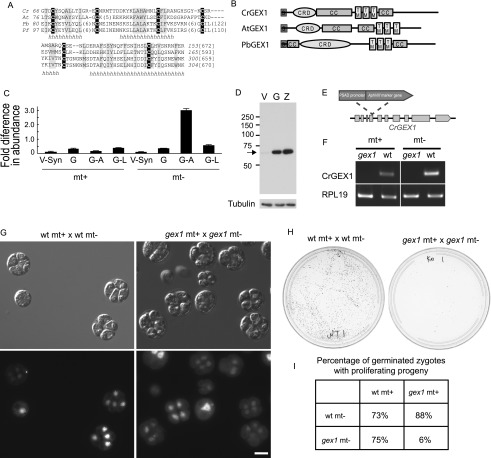Figure 3.
Characterization of CrGEX1. (A) The 88-residue CRD is present in Chlamydomonas (Cr), P. berghei (Pb), Plasmodium falciparum (Pf), and Arabidopsis (At). (B) GEX1 family members have a predicted N-terminal signal peptide, two coiled-coil domains (CC), three transmembrane domains (TMs), and a CRD. (C) Levels of CrGEX1 transcripts expressed relative to the housekeeping gene RPL19. Error bars show standard deviations of three or more replicates. (D) Immunoblot showing CrGEX1 protein in synchronized mt− vegetative cells (V), gametes (G), and zygotes formed from mt+ and mt− gametes (Z). (E) Structure of the CrGEX1 genomic locus, illustrating insertion of the aminoglycoside 3′-phosphotransferase type VIII-encoding gene (AphVIII) at the second of 10 exons (boxes). (F) Diagnostic RT–PCR of cDNA showing the absence of CrGEX1 transcripts in gex1 gametes. (G) Differential interference contrast and fluorescence microscopy images of germinated zygotes formed from fusion of wild-type plus gametes with a wild-type minus gametes (shown in the left panel) and from gex1 plus gametes fused with gex1 minus gametes showing that most gex1/gex1 zygotes underwent meiosis to form progeny. Bar, 5 μm. (H) Agar plates 5 d after induction of germination showing that most progeny from gex1/gex1 zygotes failed to proliferate. Equal numbers of zygotes were plated. (I) Table showing percentage of zygotes examined 24–30 h after induction of germination whose progeny had begun to proliferate.

